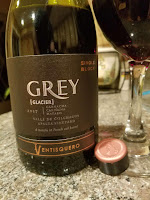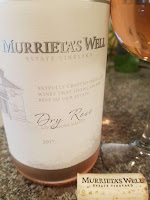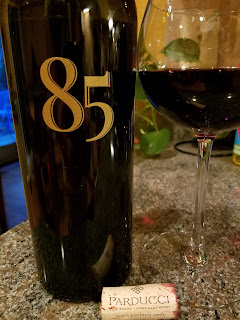The beauty of each year's Wine Bloggers Conference is you never know what type of wine you will discover, whether from the year's host region, New York's Finger Lakes in 2015, or from another region. This year I tasted wine made in Lebanon, Brazil, Vermont, Maryland, Virginia, British Columbia, along with more traditional wine making regions in Germany, Austria, Italy, Chile, and Argentina. But it was tasting wines from Spain where I had the most memorial experience.
Late to the Friday afternoon lunch, I settled down at the first open table and was soon accompanied by Carl Giavanti of
Carl Giavanti Consulting. We were seated across from who we would later learn to be Peter Deutsch and José A Hidalgo (
El Muro del Vino). After listening to their conversation we remarked about Peter's English accent but impeccable Spanish. He then explained his negociant background and the launch of his new brand
Finca Hispana which focuses on small producers throughout Spain. At the end of our conversation he invited us to his conference after party to taste these wines. I was intrigued.
 |
| Campos Reales Tempranillo |
After the Rockwell Museum visit I hurried over to the designated room just as José was propping up a large vertical display sign to prop open the door. There weren't that many visitors the first night, so this evening started with just me and José tasting two of his wines, the easy drinking
Campos Reales Tempranillo ($10) and the more complex
Darcio
Rioja Reserva ($20). The grapes for the first wine were grown in D.O. La Mancha and José opened Google Maps on his phone and we spent an entire glass zooming to the specific vineyards. Can't get more intimate than that. Plus the wine was fantastic - very easy drinking and heavy on the blackberry. As for the Rioja, I'll let Aurelio Montes, of
Kaiken Wines, describe: "It is a wine
with great fruit expression, where the wood is well integrated with the
wine. The palate is elegant, soft tannins, good volume".
By this time, Carl and Todd Trzaskos, author of the newly released
Wines of Vermont
, joined me and we turned our attention to Peter and the
Finca Hispana brand. The first item to note is that almost all these wines retail for less than $15. Second, they come with attractive packaging. The label consists of a photo of the winemaker(s) providing a personal connection between consumer and producer. And being a small group Peter was had time to discuss each winemaker, each region, and each grape. Finally, the wines are simply delicious with ridiculous values.
 |
| Garnacha/Cariñena | | Roble |
 |
| Garnacha/Carignan/Syrah |
One of the early favorites was the
Finca Hispana Garnacha/Cariñena Roble, 2011 ($15, 13.5% ABV) produced by the Cristobal family. The wine itself is a 50-50 blend of Garnacha and Cariñena, made grapes harvested from 80+ year old vines in DO Cariñena, located in northern Spain. It is a full bodied wine, with a juicy and chewy texture, finishing with plenty of spicy tannins.
Another wine I returned to was the
Finca Hispana Garnacha/Carignan/Syrah DO Monsant ($10, 13.5% ABV). The blend consists of 40% Garnacha, 40% Carignan, 20% Syrah all from vines aged between 30-60 years old in DO Monsant - the center of Catalonia and surrounding DOQ Priorat. This is a juicy fruit forward wine produced by the label model Eugènia Guasch López.
 |
| Pedro Ximenez, NV |
Eventually the tasting turned to three sherries and the true love affair began. Two of these had graduated from the traditional Solera system, 36 years in all, and are of course comprised of 100% Pedro Ximenez. The clear attraction was the
Finca Hispana Pedro Ximenez, NV ($15, 15% ABV) produced by Marta Leiva Vilchez in the D.O. Montilla Moriles appellation. The wine is luscious, with a jammy fig and tobacco profile, and a lingering dry finish. We would have continued yet the hotel security threatened Police action, so off to bed. But they promised to re-open the next evening.
And obviously news about the wine had spread. The next evening I arrived a little late after tasting some cider and could barely fit through the door. I had promised to share some local cider and beer and found myself pouring Maryland's
Millstone Cellars Farmgate cider to both José and Aurelio Montes. What a treat discussing the cider and having them compare the cider's qualities to wine faults. Over time we switched over to Virginia's
Old Ox Brewery Kristin’s Passion, a Mexican Hot Chocolate Porter, and a couple from
O'Connor Brewing Co.. Once again the evening ended with sherry and the hotel security. Finca Hispana hits is available in most other East coast markets and Chicago and hits the Virginia market later this year. Can't wait. Cheers.










































